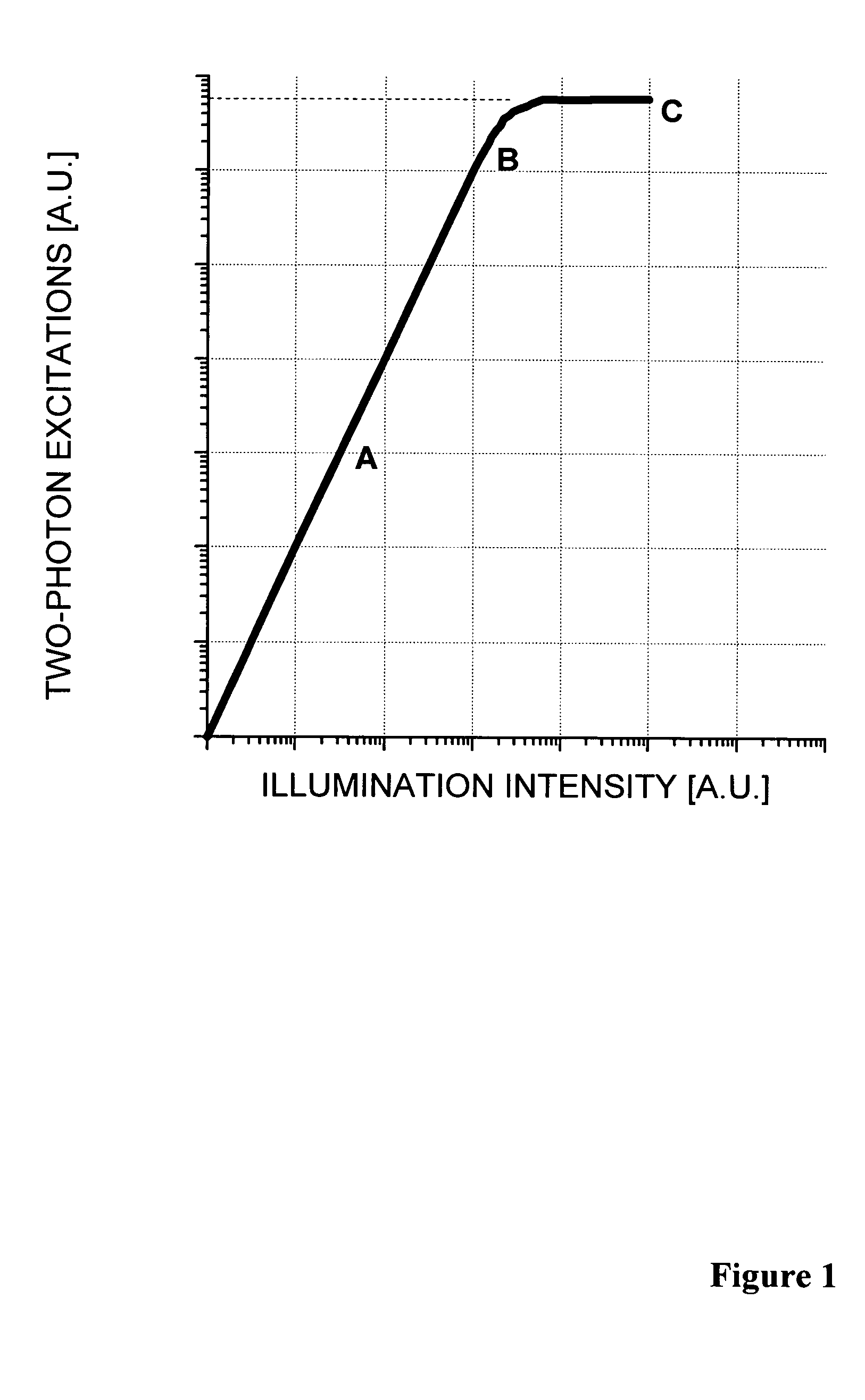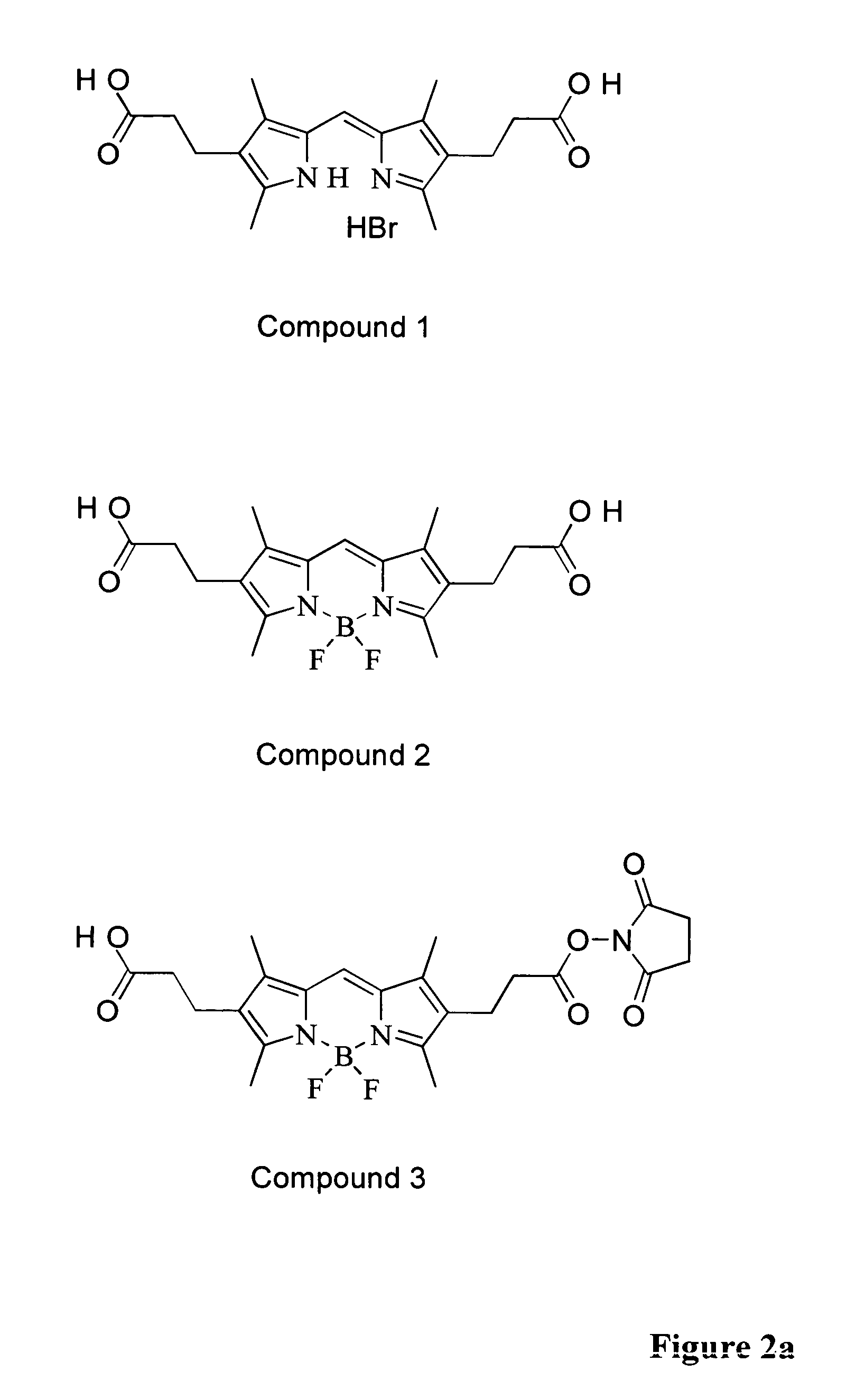Two-photon absorbing dipyrrometheneboron difluoride dyes and their applications
a dipyrrometheneboron and difluoride dye technology, applied in the field of dipyrrometheneboron difluoride dyes, can solve the problems of limited use of biomolecule fluorescent labeling, low signal level, and phenomenon that remained for a long time without practical use, and achieves improved separation free
- Summary
- Abstract
- Description
- Claims
- Application Information
AI Technical Summary
Benefits of technology
Problems solved by technology
Method used
Image
Examples
example 1
3,3′,5,5′-tetramethyl-4,4′-carboxyethyl-2,2′-dipyrrylmethene hydrobromide (1)
[0065]2-ethoxycarbonyl-3,5-dimethyl-4-methoxycarbonylethylpyrrole (1.0 g, 3.35 mmol) was dissolved in formic acid (3 ml) and hydrobromic acid (48%, 3 ml) was added. The reaction mixture was stirred at 100° C. for 2.5 h. After cooling the mixture to room temperature it was left to stand overnight at room temperature. The product crystallised out from the reaction mixture as small, orange, needle-like crystals. The reaction mixture was filtrated and the crystalline product was washed with water. The product, compound 1, was dried in vacuum desiccator. The yield was 677 mg (84%). Additional amount (43 mg) of product was obtained from the filtrate after 2 day standing at +4° C. The total yield was 720 mg (86%). 2-ethoxycarbonyl-3,5-dimethyl-4-methoxycarbonylethylpyrrole was prepared as described in Bullock E. et al., J. Chem. Soc. (1958) 1430.
example 2
4,4-difluoro-1,3,5,7-tetramethyl-4-bora-3a,4a diaza-sindacene-2,6-dipropionic Acid (2)
[0066]Dipyrrylmethene hydrobromide (compound 1) (500 mg, 1.17 mmol) was suspended in chloroform (20 ml) and triethylamine (4.3 ml, 31 mmol) was added. The starting dipyrrylmethene dissolved immediately after triethylamine addition (4.3 ml, 31 mmol). Boron trifluoride ethyletherate (5 ml, 31 mmol) was added. Reaction mixture was stirred at room temperature for 2.5 h. The reaction mixture was diluted with chloroform (50 ml), washed with dilute HCl (5%, 30 ml) and water (30 ml). Small amount (5%) ethanol was added in order to perform efficient extraction. Chloroform phase was evaporated to dryness in rotary evaporator and the product (compound 2) was precipitated from ethanol / water (7 days at +4° C.) yielding brown-orange powder. The yield after drying the product, compound 2, in vacuum desiccator was 420 mg (92%).
[0067]1HNMR (JEOL JNM-LA400, DMSO-d6, 400 MHz, δ ppm): 2.19 (s, 6H, 2x-CH3), 2.29 (t, 4H...
example 3
4,4-difluoro-1,3,5,7-tetramethyl-6-carboxyethyl-4-bora-3a,4a-diaza-s-indacene-2-propionic acid succinimidylester (3)
[0068]4,4′-difluoro-1,3,5,7-tetramethyl-4-bora-3a,4a-diaza-s-indacene-2,6-dipropionic acid (compound 2) (102 mg, 0.26 mmol) was dissolved in N,N-dimethylformamide (2.5 ml, dry). N-hydroxysuccinimide (90 mg, 0.78 mmol) and N,N′-dicyclohexyl-carbodiimide (54 mg, 0.26 mmol) were added. Reaction mixture was stirred for 24 h at room temperature. N,N-dimethylformamide was evaporated (5 mbar, 40-50° C.) and the product was purified with column chromatography using silica as a stationary phase and dichloromethane:acetone:acetic acid (100:8:1, v:v:v) as an eluent. Fractions containing the desired mono-succinimidyl ester (compound 3) were combined and evaporated to dryness. The residue was dissolved into small amount of dichloromethane. Petroleum ether (bp 40-60° C.) was added to precipitate the product. The solution was filtrated and the precipitated product (compound 3) was ob...
PUM
| Property | Measurement | Unit |
|---|---|---|
| diameter | aaaaa | aaaaa |
| concentration | aaaaa | aaaaa |
| concentration | aaaaa | aaaaa |
Abstract
Description
Claims
Application Information
 Login to View More
Login to View More - R&D
- Intellectual Property
- Life Sciences
- Materials
- Tech Scout
- Unparalleled Data Quality
- Higher Quality Content
- 60% Fewer Hallucinations
Browse by: Latest US Patents, China's latest patents, Technical Efficacy Thesaurus, Application Domain, Technology Topic, Popular Technical Reports.
© 2025 PatSnap. All rights reserved.Legal|Privacy policy|Modern Slavery Act Transparency Statement|Sitemap|About US| Contact US: help@patsnap.com



